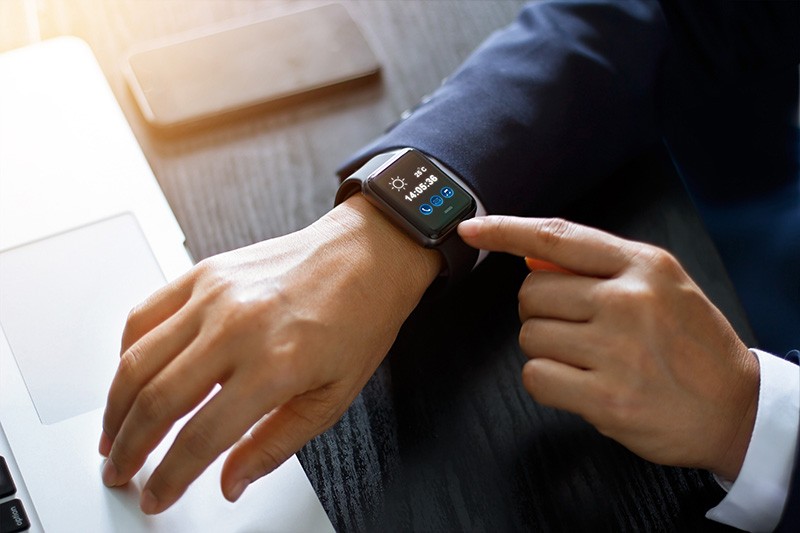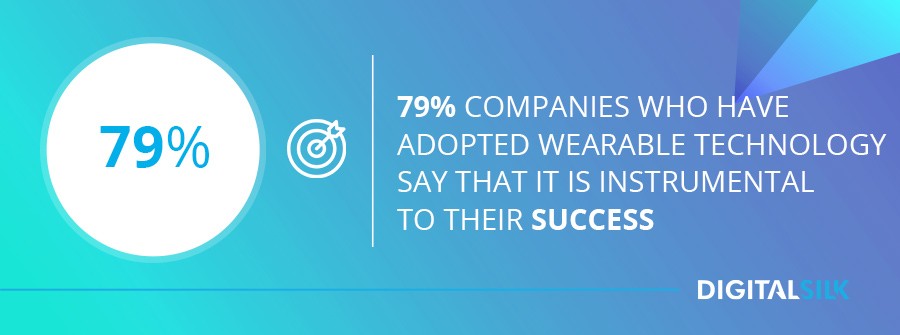 watch app over laptop and smartphone on working desk" width="570" height="380" />
watch app over laptop and smartphone on working desk" width="570" height="380" />Wearable technology in business can reach customers wherever they are, fostering brand awareness, visibility and seamless user experience.
Open Search watch app over laptop and smartphone on working desk" width="570" height="380" />
watch app over laptop and smartphone on working desk" width="570" height="380" />

The total number of connected wearable devices worldwide is expected to exceed 1.1 billion by 2022.
Wearable technology in business is revolutionizing workforce automation, from smartwatches to virtual reality (VR) headsets.
Wearables can help businesses overcome challenges in areas of employee policy, customers and assets.

Not bad for a segment that was seen almost solely, until recently, as a playground for sci-fi aficionados.
Today, wearables are scattered across the spectrum of both the consumer market and business settings and the ways in which these overlap and influence each other continue to grow.
Let’s take a look at some real-life use cases of wearables and dive into how they create market demand.
Have a development project?A study by Ericsson detailed consumer outlook on wearables that will influence the way businesses and enterprises view it as well.
Here are some of its findings:
The wearables market is largely dominated by smartwatches and health/fitness activity trackers, although the amount of use cases is gradually expanding.
Let’s look at the most common wearable technology product types that are changing the game of the consumer market – and, consequently, of entire businesses.
Smartwatches were originally associated with tracking and monitoring physical fitness (there is an entire health and fitness wearable app category derived from this).
However, their use has broadened since. Now they are mini-computers that can receive your emails, play multimedia and games, transfer files and even act as smartphones.
Hugely commercialized and usable across the spectrum, smartwatches possess a wide array of applications that make them an ideal candidate for workplace assistance and business incorporation.
Fitness trackers are pretty self-explanatory – they monitor heart rate, blood pressure, calorie consumption, distance walked and other indicators of one’s state of health.
These wearables can be strapped around the wrist or thigh, worn attached to clothing or on an armband and even implemented in running shoes with sensors via GPS tracking.
Fitness trackers can be synchronized with mobile apps in order to measure data more precisely so that individuals using them can be certain they are getting accurate readings.
Even though life-saving technology like pacemakers have long been a staple of medicine, even more high-tech prosthetics and embedded electronic monitoring devices are becoming a regular part of healthcare and medicine.
This wearable health tech, along with the apps, can assist in diagnosing health conditions and even how severe they are.
Some of the most advanced and sophisticated devices of this kind can even trace health signals such as the release of certain biochemicals.
The Internet of Things is one of the most promising niches for wearables.
Basically, it is adding the abilities of wearables, artificial intelligence and machine learning to everyday items people use in households, such as security cameras, lights, kitchen appliances and cooling systems.
All of these things are provided access to the internet through a network of wireless sensors and automation, creating the so-called concept of a “smart home.”
A smart home is a living space in which human intervention for adjusting the home to optimal conditions is minimal.
Google Home, Amazon Echo and Alexa are some of examples of these types of devices.